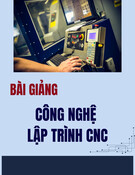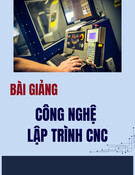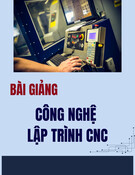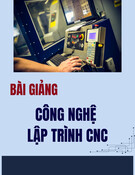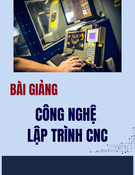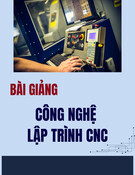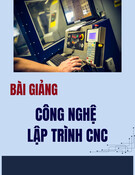
CÔNG NGHỆ https://jst-haui.vn Tạp chí Khoa học và Công nghệ Trường Đại học Công nghiệp Hà Nội Tập 60 - Số 9 (9/2024)
70
KHOA H
ỌC
P
-
ISSN 1859
-
3585
E
-
ISSN 2615
-
961
9
APPLICATION OF IMAGE PROCESSING AND RESNET-50 MODEL IN DIAGNOSING DEFECTS IN MECHANICAL PRODUCT DETAILS
ỨNG DỤNG XỬ LÝ HÌNH ẢNH VÀ MÔ HÌNH RESNET-50 TRONG NHẬN DẠNG CÁC KHIẾM KHUYẾT TRONG CÁC THÔNG TIN SẢN PHẨM CƠ KHÍ Nguyen Van Thanh1, Pham Van Nam1,* DOI: http://doi.org/10.57001/huih5804.2024.296 ABSTRACT Machine learning and computer vision play pivotal roles in detecting product defects across various industries, enhancing
effectiveness, precision, and
minimizing labor expenditures. This journal utilizes image manipulation through the OpenCV, coupled with machine learning employing the ResNet-
50 model,
to specifically identify surface defects and dimensions in bearings. Unlike prior research, the focus here lies on recognizin
g defects in mechanical parts demanding
precise machining. The ResNet-
50 model showcased an impressive 98.5% accuracy in identifying faulty bearings. Notably, the recognition outcomes from this
model surpass the accuracy of other models like YOLO and SSD. This research demonstr
ates the effectiveness of integrating advanced image processing
techniques with machine learning models, particularly ResNet-
50, in addressing the stringent requirements of identifying surface defects in mechanically critical
components. The successful application of this approach signifies its potential to revolutionize quality control processes, ensuring higher accuracy and re
liability
in defect detection within industrial and manufacturing settings. Keywords: Computer vision; faulty bearings; ResNet-50; OpenCV. TÓM TẮT Máy học và thị giác máy tính đóng vai trò then chốt trong việc phát hiện các khiếm khuyết sản phẩm ở nhiều ngành công nghiệp khác nhau, nâng cao hiệ
u
quả, độ chính xác và giảm thiểu chi phí lao động. Tạp chí này sử dụng thao tác hình ảnh thông qua OpenCV, kết hợp với máy học sử dụng mô hình ResNet-50, đ
ể
xác định cụ thể các khiếm khuyết bề mặt và kích thước trong các vòng bi. Khác với các nghiên cứu trước đây, trọng tâm ở đây là nhận diện các khiếm khuyế
t trong
các bộ phận cơ khí yêu cầu gia công chính xác. Mô hình ResNet-50 đã thể hiện độ chính xác ấn tượng là 98,5% trong việc nhận diện các vòng bi bị lỗ
i. Đáng chú
ý, kết quả nhận diện từ mô hình này vượt qua độ chính xác của các mô hình khác như YOLO và SSD. Nghiên cứu này chứng minh hiệu quả của việc tích hợp các kỹthuật xử lý hình ảnh tiên tiến với các mô hình máy học, đặc biệt là ResNet-50, trong việc đáp ứng các yêu cầu nghiêm ngặt của việc xác định các khiếm khuyết bềmặt trong các thành phần cơ khí quan trọng. Ứng dụng thành công của phương pháp này cho thấy tiềm năng của nó trong việc cách mạng hóa quy trình kiể
m
soát chất lượng, đảm bảo độ chính xác và độ tin cậy cao hơn trong việc phát hiện khiếm khuyết trong môi trường công nghiệp và sản xuất. Từ khóa: Thị giác máy tính; lỗi vòng bi; ResNet-50; OpenCV. 1Faculty of Electrical Engineering, Hanoi University of Industry, Vietnam *Email: nampv@haui.edu.vn Received: 20/4/2024 Revised: 10/6/2024 Accepted: 27/9/2024
ABBREVIATION ResNet50 Residual Network 50 layers OpenCV Open Source Computer Vision Library BGR Blue, Green, Red (Color space commonly used in digital imaging) YOLO You Only Look Once 1. INTRODUCTION In a manufacturing line, hundreds or thousands of products can be produced in an hour. However, not all products are well, and there will always be defective products. The final inspection before the products are packaged is usually done by workers, which can be time-

P-ISSN 1859-3585 E-ISSN 2615-9619 https://jst-haui.vn SCIENCE - TECHNOLOGY Vol. 60 - No. 9 (Sep 2024) HaUI Journal of Science and Technology 71
consuming and inaccurate. Nowadays, many industrial facilities have implemented machine vision technology to address this issue. Currently, many applications using machine vision technology have been developed in the agricultural sector, such as land and aerial remote sensing for natural areas to accurately assess agricultural resources, post-harvest process automation, detection, classification, and sorting, as well as product quality and safety. This is possible because the machine vision system not only identifies the dimensions, forms, colors, and textures of objects but also scrutinizes and assesses the attribute characteristics of the objects or scenes captured [7]. Image manipulation and artificial intelligence technology is also used in the medical field, diagnosing diseases through images [12]. In industry, machine vision is used in machine tools for detecting mechanical product defects, running on conveyor belts [13], or automobile disc brake inspection systems [10]. These systems use Cognex cameras and barcode readers to improve the quality of recognition and reduce labor costs. For the field of mechanical manufacturing (like satellite factories manufacturing components for automobiles, motorcycles, or other industrial goods machinery that requires high precision…), or in the field of machine fabrication, assembly in general, mechanical details such as bearings, screws, jigs,… need to be quality tested for many parameters, in which determining the size and surface defects of the details is the most common and important. Fig. 1. Conveyor belt running machine for detecting defects on the surface mechanical products
a) Type 1: Normal b) Type 2: Error not closing the ball cap
c) Type 3: Scratch/Edge defect d) Type 4: Ball cap dent error Fig. 2. Images of bearings and some basic defects The subject of investigation in this paper is silver ball bearings, as they constitute a crucial mechanical component in numerous industrial settings. These bearings serve to minimize friction and facilitate rotational movement for shafts in diverse machinery and equipment. To guarantee the caliber of ball bearings prior to their introduction to the market, the quality inspection procedure typically encompasses several stages such as material assessment, abrasion testing, lubrication examination, load assessment, durability evaluation, and more. Among these, there is a particular stage dedicated to inspecting the size and shape of the ball bearings. Specifically, adherence to technical specifications is essential, encompassing criteria such as diameter, shape precision, and surface quality. The specific research objectives of the paper are to construct an image analysis solution to classify bearing products into two types: pass and fail, specifically as follows: Inner diameter: Standard size 8 mm, tolerance requirement ±0.02mm, check the top and bottom surfaces. Outer diameter: Standard size 24 mm, tolerance requirement ±0.02mm, check the top and bottom surfaces. Surface defects, the product fails when encountering one of the errors described in Fig. 2. 2. THEORETICAL FRAMEWORD Research [6, 7] has revealed a technique for estimating an object's size by taking the area of the smallest surrounding rectangle, and merely calculating the object's outermost size. Prior research used image processing to primarily determine the size in the form of boxes, or only measured the outer radius parameters that have not been applied to complex mechanical objects, such as bearings. In light of earlier research, we provide a technique for calculating mechanical bearing radii that makes use of the smallest circle surrounding the object, as well as determining through the binary image points. To perform radius measurement, the data related to the distance in the paper need to use OpenCV, a Python library to support measuring size, distance. In this study, we use the

CÔNG NGHỆ https://jst-haui.vn Tạp chí Khoa học và Công nghệ Trường Đại học Công nghiệp Hà Nội Tập 60 - Số 9 (9/2024)
72
KHOA H
ỌC
P
-
ISSN 1859
-
3585
E
-
ISSN 2615
-
961
9
reference object method. This method is performed as follows: First, we select a standard object with known size called “Reference object”. The standard object's shape is comparable to that of the object whose shape needs to be measured, structure to make it easier to calculate. The reference object used in the study is in the form of a bearing taken from above, with a measured radius of . The next step is to capture a photo of the point of reference at a set height is 18 cm, with enough light intensity. Next, use the object separation algorithm, determine the radius of the reference object is , deduce the actual size of 1 pixel is 24,000/769 (mm) with 769 is the pixel of reference object (called the scale factor mm/px). In this research, the image undergoes conversion from BGR color space to grayscale using the cv2.cvtColor() function with cv2.COLOR_BGR2GRAY parameter, aimed at reducing image size and computational complexity. Subsequently, the cv2.GaussianBlur() function is employed to apply a Gaussian filter to the image, thereby blurring it and eliminating noise. Furthermore, redundant details are blurred to enhance image clarity. The Canny filter is then applied using the cv2.Canny() function to detect continuous edges of the object within the image. Following edge detection, object contours are identified using the cv2.findContours() function. Once contours are obtained, they are filtered to isolate the largest contour, which is then selected to determine the object's size. From this contour, the center of the object is determined, and its radii are calculated. Subsequently, the size of the object in the image is computed based on the mm per pixel ratio, denoted as the parameter P (rate). The results are then displayed or saved to a file for future reference. Finally, the radius of the object, measured in pixels, is compared to the real size of the object using the parameter P. Surface defect detection method ResNet-50, short for Residual Network with 50 layers, is a deep convolutional neural network architecture widely recognized for its remarkable performance in image classification and feature extraction tasks. This architecture addresses the vanishing gradient problem by incorporating skip connections, allowing the model to learn residual mappings instead of the actual mappings. ResNet-50 has 48 convolutional layers, and its residual blocks significantly contribute to the successful training of deep neural networks. In conventional neural networks, every layer transmits data to the subsequent layer. However, in networks incorporating residual blocks, each layer not only transmits data to the following layer but also directly to layers approximately 2-3 layers away. ResNet uses "shortcut" connections to skip through one or more layers. Such a block is called a Residual Block, as shown in the following figure. Fig. 3. ResNet 50 Adding Input X to the output of the layer, which is the addition operation depicted in the illustration, will prevent vanishing gradients because X is still added. With H(X) representing the predicted value and F(X) the true value (label), our goal is for H(X) to equal or approximate F(X). The acquisition of F(X) from X is as follows: F(X) = H(X) - X. Image processing and the ResNet-50 model can be used for surface defect detection in mechanical product details by following these steps: Image acquisition: Capture an image of the mechanical product detail using a camera. Image preprocessing: Preprocess the image to remove noise and improve image quality. This may include steps such as resizing, grayscale conversion, and contrast enhancement. Fig. 4. Processed image, labeled Feature extraction: Extract features from the image that are relevant to surface defect detection. This can be done using a variety of image processing techniques, such as edge detection, texture analysis, and region segmentation.

P-ISSN 1859-3585 E-ISSN 2615-9619 https://jst-haui.vn SCIENCE - TECHNOLOGY Vol. 60 - No. 9 (Sep 2024) HaUI Journal of Science and Technology 73
Defect classification: Use the extracted features to classify the image as defective or non-defective. This can be done using a variety comprises deep learning models, random forests, and support vector machines, among other machine learning algorithms. Defect localization: If the image is classified as defective, localize the defect in the image. This can be done using a variety of techniques, such as bounding box regression and object segmentation. Fig. 5. Training loss and accuracy graph The result above is the outcome of running the identification model on Google Colab. The input parameter requires a batch_size of 32, with a train/validation ratio of 7:3. ResNet-50's deep architecture enables it to automatically learn hierarchical features from raw images. In defect detection, these features represent distinctive patterns associated with both normal and defective product details. The model's ability to capture intricate details contributes to its efficacy in discerning subtle defects that may be challenging for traditional methods. 3. RESULTS AND DISCUSSION Determine the size of the object: The results accurately determine the size of the object with an error of ε = ±0.02mm. This outcome demonstrates how image processing technologies may be used in industrial settings to improve. Fig. 6. Results of size determination The measurement results also depend on the distance from the camera to the bearing, temporarily called h, which is summarized in the following Table 1. Table 1. Some measurement data with different heights (unit: cm) The height h (cm) between the Camera and the specimen is R = 16.002mm. 13 15 18 20 23 Measured outer radius in pixels: 929 916 769 676 568 Scale factor mm/px: 0.01722
0.01745
0.0208
0.02367
0.02817
Based on the provided data, the correlation between the distance from the camera to the bearing, denoted as h, and the scale factor mm/pixel, is derived using the Lagrange method: 432L(x)1191318833191hhhh840420140210420
where: L is the scale factor; h is the distance from the camera to the bearing. Surface defect detection results: The results of the object recognition research with the object being a bearing show that the Faster R-CNN network model can accurately identify surface defects on bearings. Defects such as cracks, scratches, and dimensional deviation are all detected and classified accurately. Table 2. Results of surface defect detection with different network architectures Backbones Accuracy Training cycle length ResNet 50 98.5% 2 hours VGG19 87% 2 hours EfficientNet-B0 91% 2.5 hours Fig. 7. Results of surface defecttion

CÔNG NGHỆ https://jst-haui.vn Tạp chí Khoa học và Công nghệ Trường Đại học Công nghiệp Hà Nội Tập 60 - Số 9 (9/2024)
74
KHOA H
ỌC
P
-
ISSN 1859
-
3585
E
-
ISSN 2615
-
961
9
This demonstrates that ResNet50 is the most reliable backbone for diagnosing defects in mechanical product components. 4. CONCLUSION In conclusion, the application of image processing techniques in conjunction with the ResNet-50 model presents a promising approach for diagnosing defects in mechanical product details. However, to further enhance the performance and accuracy of the model, it is imperative to focus on improving the model's dataset. Expanding and diversifying the dataset is crucial for the success of deep learning models. Utilizing data from various sources and contexts can help the model learn comprehensively and adaptively, thereby improving its ability to recognize and classify different variations and scenarios. REFERENCES [1]. Li Z., Li B., Li J., “An Intelligent Method for Surface Defect Detection of Mechanical Parts Based on Deep Learning,” IEEE Access, 8, 37690-37699, 2020. [2]. Singh A., Verma A. K., Singh A., “Deep learning based fault diagnosis of mechanical systems: a review,” Journal of Intelligent Manufacturing, 31(1), 1-26, 2020. [3]. Liu Y., Zhang Y., Shu L., “A defect detection method for mechanical parts based on improved deep convolutional neural network,” Journal of Intelligent & Fuzzy Systems, 41(2), 2263-2272, 2021. [4]. A. Synodinos, “Identification of railway track components and defects by analysis of wheel-rail interaction noise,” in 23rd International Congress on Sound & Vibration, 2016. [5]. H. S. Munawar, F.Ullah, A. Heravi, M. J Thaheem, A. Maqsoom, “Inspecting Buildings Using Drones and Computer Vision: A Machine Learning Approach to Detect Cracks and Damages,” Drones, 6(1), 5, 2022. doi: 10.3390/drones6010005 [6]. Othman Nashwan, Salur Mehmet, Karakose Mehmet, Aydin Ilhan, “An Embedded Real-Time Object Detection and Measurement of its Size,” in 2018 International Conference on Artificial Intelligence and Data Processing (IDAP), 2018. doi: 10.1109/IDAP.2018.8620812. [7]. I. B. Mustaffa, S. F. B. M. Khairul, “Identification of fruit size and maturity through fruit images using OpenCV-Python and Rasberry Pi,” in 2017 International Conference on Robotics, Automation and Sciences (ICORAS), Melaka, Malaysia, 1-3, 2017. doi: 10.1109/ICORAS.2017.8308068. [8]. S. Albawi, T. A. Mohammed, S. Al-Zawi, “Understanding of a convolutional neural network,” in 2017 International Conference on Engineering and Technology (ICET), Antalya, Turkey, 1-6, 2017. doi: 10.1109/ICEngTechnol.2017.8308186. [9]. Youzi Xiao, Zhiqiang Tian, Jiachen Yu, Yinshu Zhang, Shuai Liu, Shaoyi Du, Xuguang Lan, A review of object detection based on deep learning. SpringerLink, 2020. [10]. Adel Ammar, A. Koubâa, Ahmed M., Saad A., “Aerial Images Processing for Car Detection using Convolutional Neural Networks: Comparison between Faster R-CNN and YoloV3,” Preprints, 2019100195, 2019. [11]. Q. Ma, G. Tian, Y. Zeng, R. Li, H. Song, Z. Wang, B. Gao, K. Zeng, “Pipeline In-Line Inspection Method, Instrumentation and Data Management,” Sensors, 21(11), 3862, 2021. doi: /10.3390/s21113862 [12]. J. Selvaraj, P. Thangavelu, T Durai A. Kumar, S. Palaniappan, Artificial Intelligence in Biomedical Image Processing, Machine Learning and Systems Biology in Genomics and Health. In book: Machine Learning and Systems Biology in Genomics and Health 2022 [13]. Y. Chen, “Machine vision inspection technology in industrial applications detection,” Electronic Test, 18:79-80, 2015. [14]. Carlos Calderon-Cordova, María Guajala, Rodrigo Barba, et al., “Design of a Machine Vision Applied to Educational Board Game,” in International Conference on Information Technology and Science, 2016. [15]. M. J. Hasan, M. M. M. Islam, J. M. Kim, “Bearing Fault Diagnosis Using Multidomain Fusion-Based Vibration Imaging and Multitask Learning,” Sensors, 22(1), 56, 2022. doi: 10.3390/s22010056 [16]. D. Neupane, J. Seok, Bearing Fault Detection and Diagnosis Using Case Western Reserve University Dataset With Deep Learning Approaches: A Review,” IEEE Access, 8, 93155-93178, 2020. doi: 10.1109/ACCESS.2020.2990528 [17]. N. F. Waziralilah, A. Abu, M. H. Lim, L. K. Quen, A. Elfakharany, “A Review on Convolutional Neural Network in Bearing Fault Diagnosis,” MATEC Web of Conferences 255, 06002, EAAI Conference 2018. https://doi.org/10.1051/matecconf/201925506002 [18]. H. Wang, J. Xu, R. Yan, C. Sun, X. Chen, “Intelligent Bearing Fault Diagnosis Using Multi-Head Attention-Based CNN,” Procedia Manufacturing, 49, 112-118, 2020. doi: 10.1016/j.promfg.2020.07.005 [19]. K. He, X. Zhang, S. Ren, J. Sun, “Deep residual learning for image recognition,” in Proceedings of the IEEE Computer Society Conference on Computer Vision and Pattern Recognition, 770-778, 2016. doi: 10.1109/CVPR.2016.90. [20]. D.V. Dinh, P.V. Nam, N.V. Thanh, “Application of image processing and Faster R- CNN network model in error diagnosis system for mechanical product components”, Scientific Journal - Sao Do University, 2 (81), 12-18, 2023. THÔNG TIN TÁC GIẢ Nguyễn Văn Thành, Phạm Văn Nam Khoa Điện, Trường Đại học Công nghiệp Hà Nội

![Câu hỏi ôn tập Công nghệ gia công áp lực [chuẩn nhất]](https://cdn.tailieu.vn/images/document/thumbnail/2025/20250708/kimphuong1001/135x160/6311751941801.jpg)
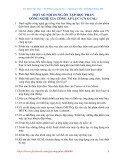
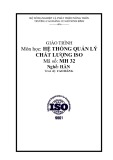
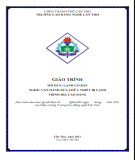
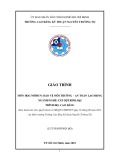





![Bài tập tối ưu trong gia công cắt gọt [kèm lời giải chi tiết]](https://cdn.tailieu.vn/images/document/thumbnail/2025/20251129/dinhd8055/135x160/26351764558606.jpg)




